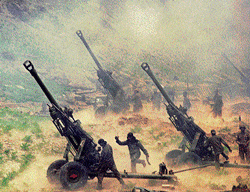
There are others, besides our jawans, who risk their lives in a bid to serve the country. Nitin Rai is one such who spent time shooting from the front as a freelance photographer during Kargil.
Nitin has covered different landmark events - including demolition of Babri Masjid and earthquake in Gujarat in 2000 but Kargil War gives him a sense of pride.
He shot Indian troops at Zoji La Pass during the war in 1999 for a German news magazine Der Spiegel. “We couldn’t go up to Tiger Hill where the Pakistani Army was firing from. We were not allowed. So we largely shot Indian troops practising and readying to go up to the hill taking shots of Bofors guns firing. Sometimes we were allowed to click, sometimes we were not,” he recalls now.
Utter ‘Kargil’ and the first thing that comes to his mind is ‘spectacular landscapes’. But the beauty was overshadowed by sounds of gunfire and shelling. “Being a journalist and having been in dangerous situations earlier also, I wasn’t scared. When you are in the middle of something like this, you can’t be scared. But I had to be extra alert. It was a very tense experience,” he shares with Metrolife.
Kargil War was not one in which Indian troops were firing from one side and Pakistani troops from another. It wasn’t ‘face to face.’ “I remember, an Army jeep got blown off in a second as it was hit by a cannon shell. The positions of the Pakistani and Indian Army were such that the former could see the latter and being on the top of a hill, the Pakistani Army could see all vehicular movement. So they could shell anytime,” he reminisces.
“There were few shrines on the Indian side. Any convoy passing through would definitely stop, pray and then move on, irrespective of whether it was a temple or mazaar. The only hope at that time you had was from the God,” he says poignantly.
In the absence of a photo studio and an internet connection in the vicinity of the war front, most of his time was spent in travelling from Kargil to Srinagar, from where he would send his pictures, so Nitin could not get more than two to three hours of working time.
Back then digital cameras were not so readily available and journalists were shooting on film, which meant it was an even lengthier process – from clicking to sending them to office. “We had hired an Ambassador car and would travel six to seven hours to reach the place from where Indian troops were firing. We would stay there, click for two to three hours and rush to Srinagar so that pictures could be processed, scanned and reach the office on time the same day,” says Nitin.
He particularly remembers being impressed with one soldier from the Sikh regiment and wanted to click him but was not allowed to do so. “He was a captain and I wanted to click his pictures while he was practising but he never let me click,” Nitin recalls.
Kargil gives him a feeling of pride even today but no good memories to bring home. Waiting at the Srinagar airport for his flight back to Delhi, the sight of Army men disturbed him. “I saw wounded Army personnel; some did not have hands, some had lost legs. It was a very, very sad sight.” And brought home the realities of the assignment he had just finished.